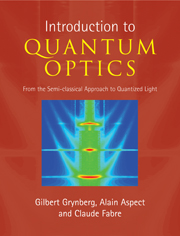Foreword
Published online by Cambridge University Press: 05 August 2012
Summary
Atomic, molecular and optical physics is a field which, during the last few decades, has known spectacular developments in various directions, like nonlinear optics, laser cooling and trapping, quantum degenerate gases, quantum information. Atom–photon interactions play an essential role in these developments. This book presents an introduction to quantum optics which, I am sure, will provide an invaluable help to the students, researchers and engineers who are beginning to work in these fields and who want to become familiar with the basic concepts underlying electromagnetic interactions.
Most books dealing with these subjects follow either a semi-classical approach, where the field is treated as a classical field interacting with quantum particles, or a full quantum approach where both systems are quantized. The first approach is often oversimplified and fails to describe correctly new situations that can now be investigated with the development of sophisticated experimental techniques. The second approach is often too difficult for beginners and lacks simple physical pictures, very useful for an initial understanding of a physical phenomenon. The advantage of this book is that it gives both approaches, starting with the first, illustrated by several simple examples, and introducing progressively the second, clearly showing why it is essential for the understanding of certain phenomena. The authors also clearly demonstrate, in the case of non-linear optics and laser cooling, how advantageous it may be to combine both approaches in the analysis of an experimental situation and how one can get from each point of view useful, complementary physical insights.
- Type
- Chapter
- Information
- Introduction to Quantum OpticsFrom the Semi-classical Approach to Quantized Light, pp. xxiii - xxivPublisher: Cambridge University PressPrint publication year: 2010



